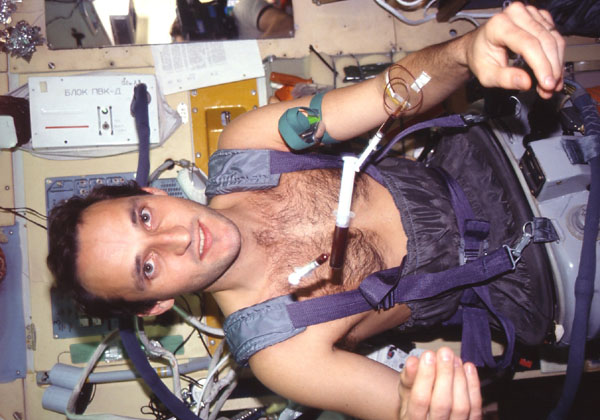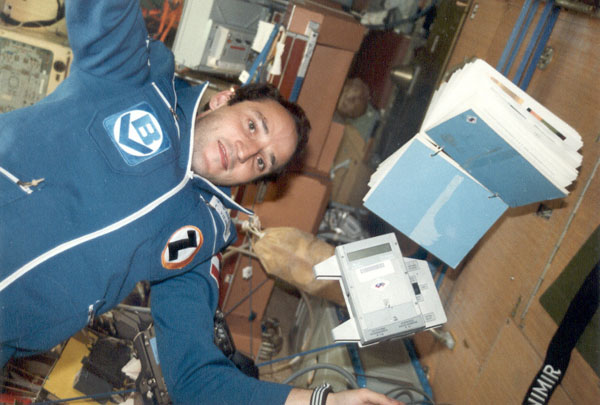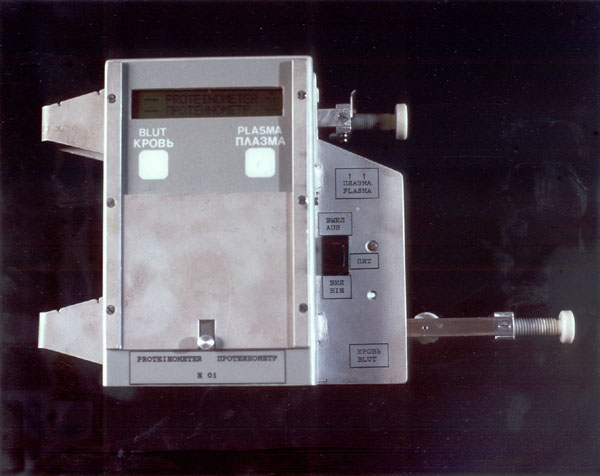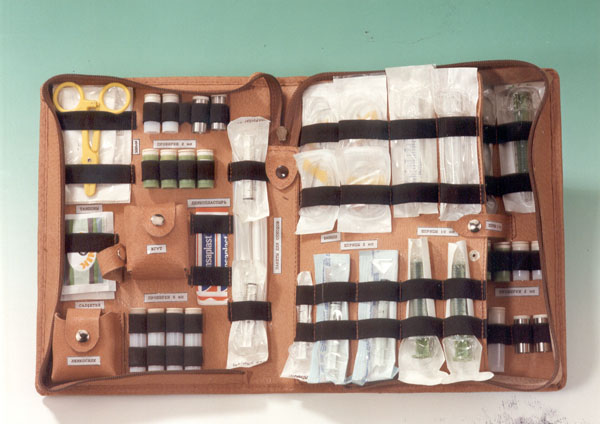Man’s circulation system is made up of the heart, circulation and body fluids. Microgravity changes the functional properties of blood and lymph vessels, heart activity, tissue spaces, central nervous system, and autonomous nerve and hormone systems.
A predetermined negative pressure on the lower part of the body can be created using a LBNP (lower body negative pressure) on board the MIR space station. It should increase the fluid pressure in the exchange vessels of the legs and affect the fluid discharge in the tissues. Such processes also lapse on earth if a person is in a peaceful upright position. LBNP systems are used as circulation training before recovery after a prolonged stay in microgravity.
Objectives
A fluid with an unknown concentration of protein appears from the capillaries and venules when applying negative pressure. The higher the protein concentration in the tissue’s fluid, the lower the „colliodmotic effect“ that counteracts the fluid in the tissue space. This mechanism is a decisive factor in the appearance of edemas as well as for tissue dehydration. In such process where fluid is discharged, the exchange of lymphal fluid also increases. The lymph vessels are a special drainage system whose task is to compensate for the normal loss of filtrate and protein in the tissues through the backhaul of blood.
Apart from the complexity of questions regarding the distribution and the blood’s distribution pattern, even the strategies of hormonal adaptation is interesting. In this context, the dynamic reaction on a reproducable stress condition was investigated.
Functionality, Measuring principle
Precise and reproducable stimuli are required for the investigation of a person’s circulation system. In the “negative pressure pants”, the LBNP system on board the space station can create a dosed negative pressure in the lower extremities.
The measuring device PROTEINOMETER can measure the acoustic velocity of the blood that is directly proportional to the protein concentration. The blood’s mass density will be higher, depending on the amount of red blood cells and therefore increasing the acoustic velocity. However the changes are extremely small.
Apart from protein, a number of hormones and blood plasma of the cosmonaut were determined. These give information about the stress and saltwater exchange. The cosmonaut himself took blood samples using the VENE set, taking about 5ml blood plasma every time. The blood samples were brought back to earth for further analysis. In a mission involving the Austrian embassy in Moscow and the AUA, the plasma samples were quickly brought to Austria for analysis.
Shared equipments of the Austrian payload
MONIMIR
Results
Interesting data was collected regarding the adaptation of man in microgravity as well as the re-adaptation to terrestrial gravity. The results made it possible to identify the dynamic character of physical-chemical blood properties and the reactions of hormonal volume regulation systems on the LBNP (Lower Body Negative Pressure) exposure in microgravity and in the early phase after the flight.

An important result of the experiment was the measurement of acoustic velocity in blood plasma, whereas the protein concentration could be determined. The Austrian cosmonaut took blood samples three minutes after the start of the LBNP exposure and two minutes after it ended. The reference measurements before the flight showed an increase of acoustic velocity whilst under the influence of LBNP. This was 1.6 m/s in the blood and 1.2 m/s in the plasma, whilst the values after the flight were 4.0 m/s in the blood and 1.7 m/s in the plasma. The findings onboard the space station: Acoustic velocity didn’t increase in the plasma or in the blood. It is higher during the early re-adaptation phase to microgravity than before the flight. The absence of changes in acoustic velocity during the flight was an unexpected result and will be indirectly confirmed through the later results about impedence changes in the leg under the influence of LBNP (German MIR Mission 1992).
Hormone adapatation processes were partly changed compared with reference investigations. The experimenters of BODYFLUIDS were mostly interested about those hormones that influence fluid balance regulation and blood volume or the revelations about a common stress level of the test person. The surprising result: The stimulus of the peptide ANP under LBNP on the sixth day in microgravity. The absolute value of antidiuretic hormone Vasopressin was five times higher during the flight than terrestrial laboratory conditions before the flight. This result is also noticeable, although similar increase of ADH was observed during a previous flight.

The secretion dynamic of the hormones and their ability in rash concentration changes and dependent on the test person’s stress, the hydration status, nourishment, and various environmental factors is already known. Special attention was given to the last mentioned factor. The investigations widen the already available information on the mechanism of hormone adaptation in microgravity. But they also bring up new questions.
It shows that the massive LBNP log and the flight conditions of the cosmonaut did not increase the stress factor that activated the sympathetic adrenergic. Concurrently, the LBNP test showed an increase of the stress hormone adrenalin and the indication for an increased reactivity of the mineral corticoid system during the flight.
The cosmonauts had problems keeping an upright position when they returned back on earth. This phenomen, known as orthostatic liability, is commonly known. A high concentration of aldosterone, noradrenalin and cortisol, a distinct haemoconcentration as well as a strong reaction of plasma-renin activity could be shown with the help of the dynamic LBNP test. This condition also persisted on the fourth day after the flight.
The BODYFLUIDS flight experiement brought numerous new and unexpected results that are important for the understanding of physiology of man.
Practical application
Application ranges
- Clinical and experimental medicine and physiology
Application target
- Diagnostics of discrepancies in the salt- water balance
- Hormonal circulation checkup with specific endurance tests
- Evaluation of dynamic of the hemo- and plasma density of people in norm and pathology
- Formation non-medicamentous treatment for patients with circulatory troubles
Direct interested institutions on the utilization of the experiment results
- Physiological Institute, University Graz
- Institute for Biomedical Problems, Moscow
- Institute for Experimental Endocrinology, Bratislava, CSFR
- “J.A. Gagarin” – Cosmonauts training center in Svjosdnyj Gorodok near Moscow
Technical characteristics
For the experiment BODYFLUIDS the apparatures PROTEINOMETER and the set for taking blood samples VENE were needed.
The equipment PROTEINOMETER
The apparat PROTEINOMETER allowed the determination of the protein content in the whole blood and the plasma through the measurement of the following parameters:
- Sonic run-time through the bio-material probe (0 – 400 µs)
- Temperature of the bio-material probe (10 – 40 °C)

The energy supply of the equipement was carried out autonomous by a set of batteries with a voltage of 9V.
Control elements:
- Master switch
- Start-button for the blood measurement
- Start-button for the Plasma measurement
- Display elements:
- LCD-Display
| Mass: | max. 1.4 kg |
| Dimensions: | 200 mm x 175 mm x 75 mm |
Blood sample taking set VENE
The blood sample taking set included the following expendables for the intravenous blood taking and was packed in a leather sheath:

- Shots in different dimensions (22 pieces)
- Eprouvettes in differnt dimensions (24 pieces)
- Butterfly-cannulae (8 pieces)
- Compressions (2 pieces)
- Pads (8 pieces)
- Disinfectant pads (4 pieces)
- Leucoplast (4 pieces)
- Adhesive tape
- Waste bag
- Hose clamps
| Mass: | max. 1.2 kg |
| Dimensions: | 300 mm x 250 mm x 100 mm |
Experimenters
o. Univ.-Prof. Dr. Thomas Kenner (institute manager)
Univ.-Prof. Dr. Helmut Hinghofer-Szalkay (project manager)
Dr. Eva Maria Koenig
Dr. Gabriele Sauseng-Fellegger
all: Physiological Institute of the University Graz
Sub-contractor:
Dr. Hans Stabinger
Ing. Johann Schmied
Dipl.-Ing. Dr. Helmut Heimel
all: Laboratory for Measurement Technique, Graz
o. Univ.-Prof. Dr. Hans Leopold (institute manager)
C. Zambo-Polz
all: Institute for Electronics, Technical University Graz
